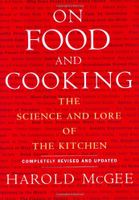Advertisement
Butter
By Harold McGee
Published 2004
Like its parent material, cream, butter is an emulsion: but it’s one of the few food emulsions in which the continuous phase is fat, not water. In fact, butter is made by “inverting” the fat-in-water cream emulsion to produce a water-in-fat emulsion. The continuous fat phase of butter, together with some intact fat globules that survived churning, takes up about 80% of its volume, and the dispersed water droplets about 20%. When it melts, the heavier water droplets sink to the bottom and form a separate layer. The consistency of melted butter, then, is the consistency of the butterfat itself, which thanks to its long fat molecules is naturally more slow-flowing and viscous than water. So melted butter, whole or clarified (“drawn”) to remove the water phase, makes a simple and delicious sauce. Cooks also heat whole butter until the water boils off and the milk solids turn brown, which gives the fat a nutty aroma. The French beurre noisette and beurre noir, or “hazelnut” and “black” butters, are such browned butters, often made into a temporary emulsion with lemon juice and vinegar respectively.


